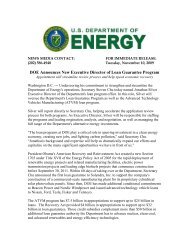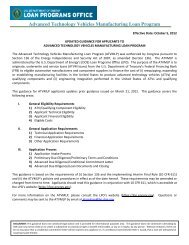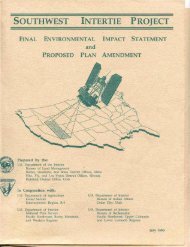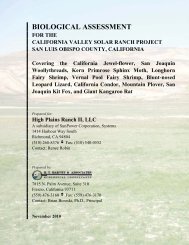Bureau of Land Management's Decision Record and Environmental
Bureau of Land Management's Decision Record and Environmental
Bureau of Land Management's Decision Record and Environmental
You also want an ePaper? Increase the reach of your titles
YUMPU automatically turns print PDFs into web optimized ePapers that Google loves.
Jersey Valley Geothermal Development Project<br />
<strong>Environmental</strong> Assessment: NV063-EAO8-091<br />
with native oral history can reveal information pertaining to past cultural activities <strong>and</strong><br />
associated social practices, trade routes, subsistence activities, environmental changes, etc.<br />
Roads leading to project activities, can experience further use by members <strong>of</strong> the public to access<br />
formerly inaccessible locations. If members <strong>of</strong> the general public increasingly utilize Project<br />
roads, the cultural/traditional/spiritual integrity <strong>of</strong> any adjacent Native use site may be<br />
compromised.<br />
Also, the act <strong>of</strong> drilling wells (regardless <strong>of</strong> the data being sought) is <strong>of</strong>ten viewed by traditional<br />
practitioners <strong>and</strong> believers as being harmful to “mother earth” due to impacts to underground <strong>and</strong><br />
surface waters, which are considered the “life blood <strong>of</strong> the Earth <strong>and</strong> all who dwell upon it.”<br />
Other than consumption by people, wildlife, <strong>and</strong> plant species, certain hot <strong>and</strong> cold spring<br />
locations are also used for healing <strong>and</strong> spiritual purposes. For this specific Project to date,<br />
contemporary traditional/cultural uses have not been identified within or near the Project<br />
boundaries. However, continued consultation may reveal otherwise.<br />
During the Project activities, if any cultural properties, items, or artifacts (stone tools, Projectile<br />
points, etc...) are encountered, it must be stressed to those involved in the proposed Project<br />
activities that such items are not to be collected. Cultural <strong>and</strong> Archaeological resources are<br />
protected under the Archaeological Resources Protection Act (16 U.s.c 470ii) <strong>and</strong> the Federal<br />
<strong>L<strong>and</strong></strong> Management Policy Act (43 U.S.C. 1701). The above language is applicable to previously<br />
identified artifacts <strong>and</strong> site locations, surface artifacts possibly missed during the original survey,<br />
<strong>and</strong> any subsurface artifacts (below ground).<br />
Though the possibility <strong>of</strong> disturbing Native American gravesites within most Project areas is<br />
extremely low, inadvertent discovery procedures must be noted. Under the Native American<br />
Graves Protection <strong>and</strong> Repatriation Act, section (3)(d)(l), it states that the discovering individual<br />
must notify the l<strong>and</strong> manager in writing <strong>of</strong> such a discovery. If the discovery occurs in<br />
connection with an authorized use, the activity, which caused the discovery, is to cease <strong>and</strong> the<br />
materials are to be protected until the l<strong>and</strong> manager can respond to the situation.<br />
If any traditional cultural properties or artifacts are identified before or during development<br />
activities, a protective “buffer zone” may be acceptable, where physical avoidance is an issue,<br />
<strong>and</strong> if doing so satisfies the needs <strong>of</strong> the BLM, the proponent, <strong>and</strong> affected Tribe. The size <strong>of</strong> any<br />
“buffer zone” would be determined through coordination <strong>and</strong> communication between all<br />
participating entities. All NRHP-eligible <strong>and</strong> unevaluated cultural sites that were identified<br />
during the cultural resources inventory would be avoided.<br />
3.4.2.2 Alternative 1<br />
The impacts to Native American Religious Concerns from the construction, operation,<br />
maintenance <strong>and</strong> reclamation <strong>of</strong> Alternative 1 would be the same as those described for the<br />
Proposed Action.<br />
- 42 -







